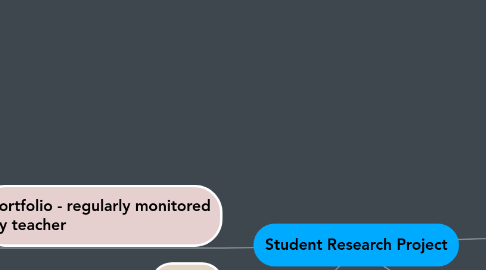
1. Portfolio - regularly monitored by teacher
1.1. Section 1: Planning
1.1.1. Literature review/notes. Create annotated bibliographies.
1.1.2. Reference lists. See reference manager (see other idea tab).
1.1.3. Research ideas. Brainstorming activity.
1.1.4. Research plan (concept map)
1.1.5. Refined & justified research question and hypothesis
1.1.6. Layout
1.1.6.1. Table of contents
1.1.6.2. Date
1.1.6.3. Page numbers
1.2. Section 2: Data collection & analysis
1.2.1. Methodology
1.2.2. Publicly available datasets, including selection criteria
1.2.3. Recording, processing, organising and storing data
1.2.4. Analysing datasets, including statistical analyses
1.2.5. Manipulation, Presentation and analysis of data
1.3. Section 3: Reflection
1.3.1. Discussions with peers, teachers and mentors
1.3.2. Revisions of research, including justifications; suggestions for improvements
1.3.3. Plausibility and logical progression of scientific arguments
1.3.4. Use of scientific language
1.3.5. Future research directions
1.4. Types
1.4.1. Digital
1.4.1.1. Google docs or Microsoft Office.
1.4.1.1.1. Develop proper archiving/annotation system
1.4.1.2. Google Keep, OneNote or Evernote are OK, provided they are properly organised and maintained.
1.4.1.3. Other online/cloud-based systems
1.4.2. Paper-based
1.4.2.1. Labook or a folder system
1.4.2.1.1. Must include printouts, attachments, etc.
1.5. Storage
1.5.1. Backup
1.5.2. Security
1.5.3. Accessibility to teacher
1.6. Declaration
1.6.1. Form must accompany portfolio
1.7. Acknowledgement
1.7.1. Acknowledge all resources, including advice and assistance
1.7.2. Plagiarism avoidance
1.8. Referencing
1.8.1. Using reference management software
1.9. Assessment
1.9.1. Research proposal
1.9.1.1. The presentation/report may include: - an overview of the research proposal - the hypothesis - project milestones, timeline and rationale - proposed methods of statistical analysis and visual representations to further support their proposal - a question and answer session (presentation).
1.9.2. Literature review
1.9.2.1. - Literature review topic must not replicate the research topic of any student enrolled in the course. - Literature reviews are a key component in any research paper, report and thesis. They form the basis for coherent delivery of information to various stakeholders. - Literature reviews may require students to: - explain and justify significant findings and research methods of other scientists - understand and communicate the current status of the research topic - compile reference lists and apply in-text referencing.
1.9.3. Statistical case study
1.9.3.1. The selected topic or data for the statistical case study must not replicate the research topic of any student enrolled in the course. Case studies allow previously collected and analysed data to be evaluated by students in examination or open book conditions. A case study may allow students to: - demonstrate application of statistical techniques - describe trends and patterns in data sets - compare graphical representations of data - construct conclusions - describe limitations - discuss ethical considerations of the topic.
2. Report
2.1. Based on research portfolio
2.2. All my own work
2.3. Structure
2.3.1. Title
2.3.1.1. Provides the aim of the investigation
2.3.2. The Abstract
2.3.2.1. - One paragraph - 100–200 words - Summary of the scientific research investigation. - It contains the question, the methods, key results and conclusions. - Referencing is not needed in the abstract.
2.3.3. Literature Review
2.3.3.1. - 750–1000 words - relevance of the scientific research and includes background information - It is usual to start the review with a broad scope and become more specific. - Sources used are to be current and, where possible, original articles referenced rather than reviews of the articles.
2.3.4. Research Question
2.3.4.1. -Addresses a single independent variable but may be broken down into subparts if multiple aspects are involved and are directly related. -The Scientific Research Project should have a single major focus and subsequently only one main scientific research question. -The question should be clear, precise and specific; written in scientific language, and be developed from the review of the literature.
2.3.5. Hypothesis
2.3.5.1. -A hypothesis is a proposed explanation for a phenomenon. - It relates an independent variable to a dependent variable in a causal relationship that can be tested.
2.3.6. Methodology
2.3.6.1. - The methodology is usually written first and is refined as the scientific research progresses. - Written in passive voice, simple past tense - Contain enough specific and detailed information so that it can be repeated by another scientist to obtain the same results.
2.3.7. Results
2.3.7.1. - Describes what was observed, calculated or the trends discovered. - It is not an explanation of the results. - Results may include tables, graphs and/or other visual representations to highlight important features. - It may be relevant to comment on the degree of uncertainty stated for each set of data collected. - All visual displays should be labelled with a number, concise name and a stand-alone description of how the result was obtained.
2.3.8. Discussion
2.3.8.1. - 700–1200 words - Forms the argument and provides an explanation of the phenomenon that was investigated. - Other peer-reviewed scientific research should be used and referenced to discuss findings and to form an academic argument. - Includes an evaluation of the data-analysis and an explanation of the results, why they occurred, key limitations - Further implications with suggestions for future directions of scientific research.
2.3.9. Conclusion
2.3.9.1. - 250–500 words - A summary of the scientific research findings - One or two paragraphs in length - Should not introduce new information.
2.3.10. Reference List
2.3.10.1. - All sources of information and data that are used to inform the scientific research should be cited using an appropriate footnoting and referencing style.
2.3.11. Appendices
2.3.11.1. - Appendices are not essential - Relevant documents that are either too large or that detract from the flow of the report. - They are to be numbered and referred to in the text.
3. Area of interest
3.1. Science discipline
3.2. Decide after reviewing literature
3.3. Choose a specific and narrow topic
3.4. Sufficient and readily-accessible dataset
3.4.1. Australian Health Survey
